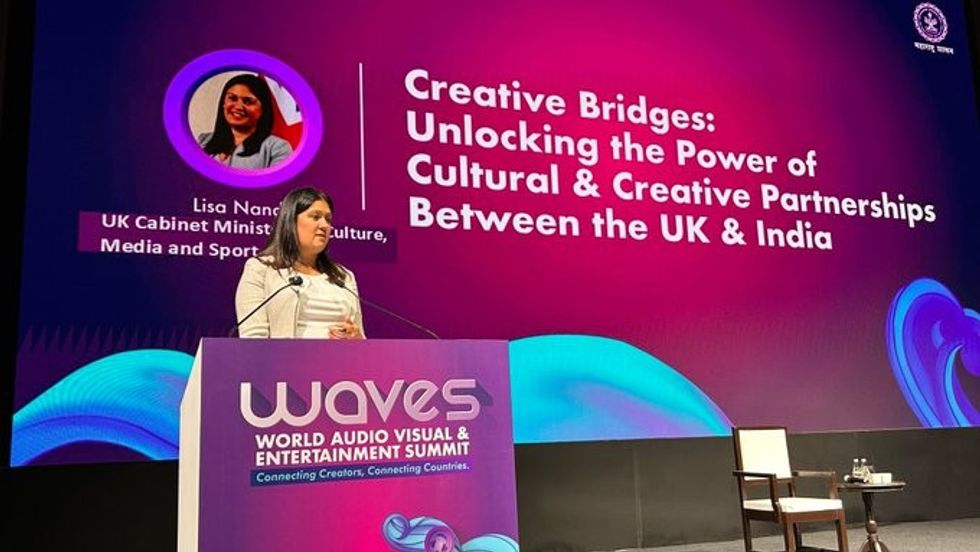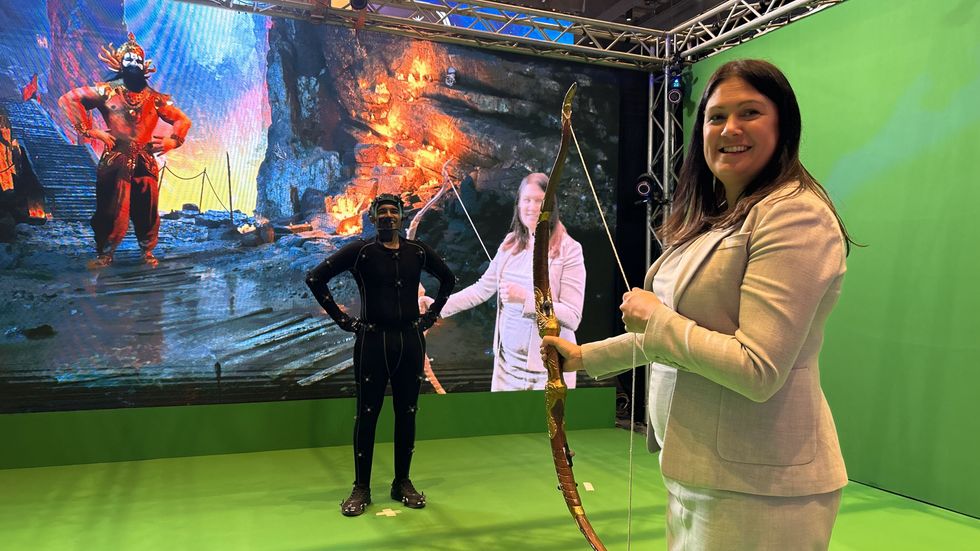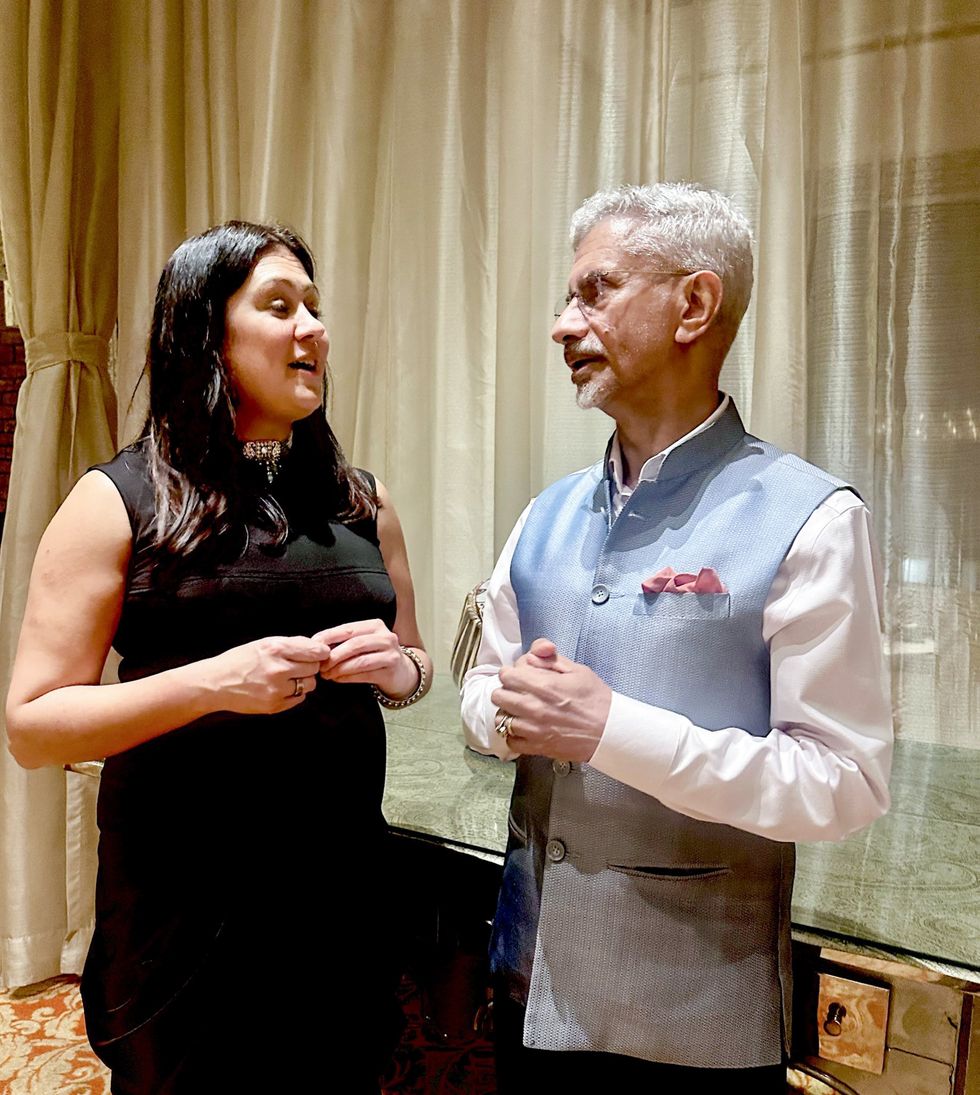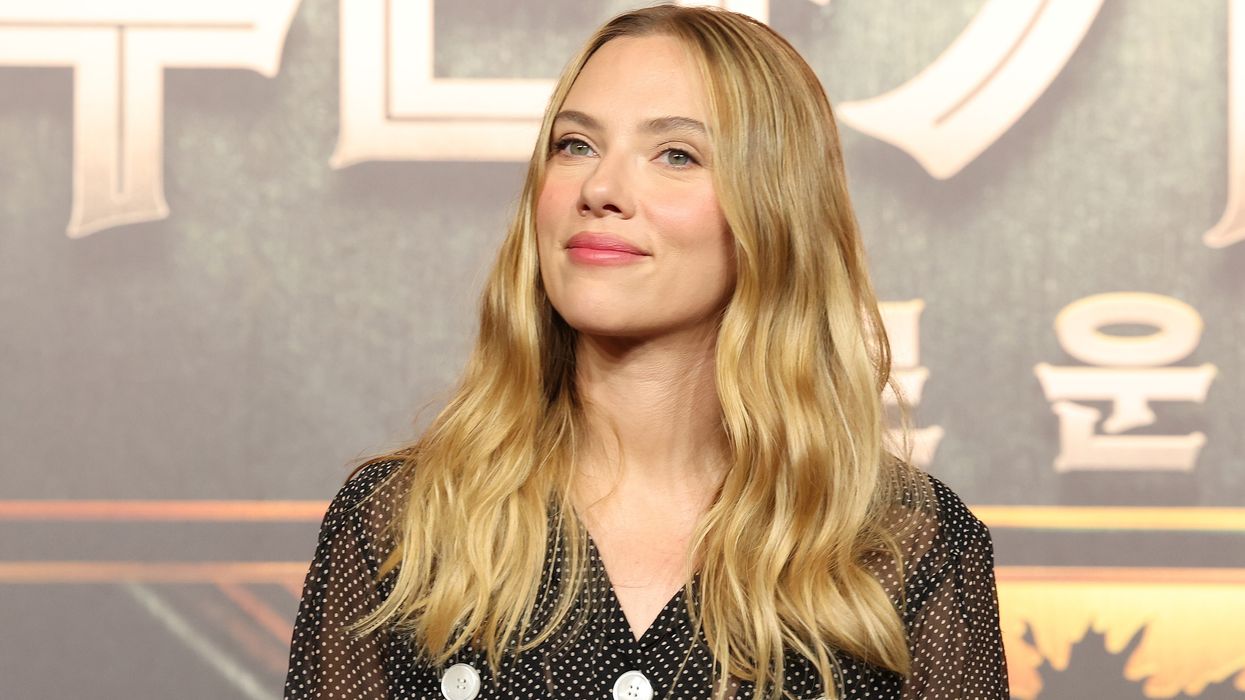LISA NANDY has established herself as one of the most important members of Sir Keir Stamer’s cabinet by signing what appears to be a far-reaching cultural agreement with India during a four-day visit to Mumbai and Delhi.
Britain’s secretary of state for culture, media and sport said: “In the arts and creative industries, Britain and India lead the world, and I look forward to this agreement opening up fresh opportunities for collaboration, innovation and economic growth for our artists, cultural institutions and creative businesses.”
After her visit, British Indian voters might well feel that in Nandy they have a friend in the government.
She signed the agreement with her equally upbeat opposite number, Gajendra Singh Shekhawat, India’s minister of culture and tourism.
He posted a message on X, as well as photographs with Nandy: “Pleased to have signed the India-UK programme of cultural cooperation with UK secretary of state for culture, media & sport. Aimed at celebrating the deep-rooted bonds between our peoples, this partnership will aid and nurture the voices of our youth, uplift emerging artists, and honour the cultural expressions of our diaspora as well as our marginalised communities.
“Together, we’re building a living bridge of shared stories, creativity, and heritage that connects hearts across borders.”
The venue for the signing was the National Gallery of Modern Art in New Delhi. Nandy was flanked by members of her delegation, including senior representatives of Arts Council England, the British Library, the British Museum, the Natural History Museum, the Science Museum, the V&A Museum and VisitBritain.
A senior gallery official remarked: “Both ministers were very happy to sign this pact. And it will foster greater cultural cooperation between the two countries, which have a long-shared history.”
According to DCMS (department of culture, media and sports), “the UK’s arts and culture, creative industries, tourism and sport sectors are set to benefit from a major new cooperation deal and economic links with India, as the government delivers on its ‘Plan for Change’ to boost growth and opportunity”.
“The agreement will open the door for increased UK creative exports to India and enable more partnerships between UK and Indian museums and cultural institutions, helping to grow UK soft power.
“Implementation will involve the British Council in India and the Indian Ministry of Culture, with participation from major UK cultural institutions including Arts Council England, the British Library, the British Museum, Natural History Museum, Science Museum Group and the V&A Museum.
“This has the potential for British museums to launch new partnerships on exhibitions or public programmes that engage the Indian diaspora in the UK.
“The UK will work with India to support best practice and expertise on heritage conservation, museum management and digitisation of collections, including making knowledge contained in south Asian manuscripts more widely accessible, and the protection of cultural property, with both nations committing to combat illicit trafficking of cultural artefacts.”
There are plans to encourage more Indian tourists to come to Britain. VisitBritain forecasts a record 766,000 visits from India to the UK in 2025, up seven per cent on 2024, with travellers spending £1 billion – a 12 per cent year-on-year growth.
In Delhi, VisitBritain CEO Patricia Yates launched the “Starring GREAT Britain” campaign, which draws upon film and TV locations as a driver for inward tourism in the UK.

There already exists a tourist map of Britain, full of dots to show the locations where Bollywood movies have been shot. For example, locations used in hit film Kabhi Khushi Kabhie Gham (2001) include Stowe School and Waddesdon Manor, both in Buckinghamshire, and Blenheim Palace in Oxfordshire. But the map needs to be updated.
The British Phonographic Industry (BPI) has reported that British music exports to India experienced a significant 26.3 per cent increase in revenue. This moves India into the top 20 biggest overseas territories for UK recorded music, and there have recently been tours by major British acts, including Coldplay in January and Ed Sheeran in February.
In Mumbai, Nandy delivered a keynote address at the World Audio Visual and Entertainment Summit (WAVES), which was also attended by the Indian prime minister, Narendra Modi.
In her speech, Nandy repeated many of the points she made recently in London at the reception DCMS hosted jointly with the Indian high commission.
She referred to her father, Dipak K Nandy, who arrived in Britain from Kolkata in 1956 and will turn 89 on May 21: “The relationship between India and the UK is strong and deep, and it is personal for me. My father grew up in Kolkata, where my Indian family still live, and I’m deeply proud to be the first-ever Labour cabinet minister of Indian heritage in the United Kingdom.”
She referenced several Indian-origin personalities of note, among them Sophia Duleep Singh, Rishi Sunak, Charli XCX, Nikita Chauhan, Baroness Shriti Vadera, Chila Burman and Gurinder Chadha.
She touched on Modi’s inaugural address: “Nobody could have listened to that opening speech from the prime minister and not understand that this is anything less than a personal signal of intent that he will leave no stone unturned in his mission to power up the untapped potential that exists in the already global success story of Indian film, literature and fashion, and we share that ambition, for you and for us. Now is the time to work together to put rocket boosters under our creative and cultural industries for growth, prosperity and power.
“My ambition is for our cooperation to lead a cinematic revolution that has impacts far beyond the screen.
“Both the UK and India boast rich cinematic traditions and share a deep mutual interest in each other’s storytelling cultures. Already we’re seeing success. British crews working on Indian sets, Indian directors bringing their vision to British audiences, and streaming services that offer a bridge between our cultures.
“Across the creative industries in goods services and especially audio-visual services, India is one of our most important partners. Given the size of our markets and the scale and quality of our television and film sectors, I know we can be more ambitious.”
Nandy said apart from the well-known cultural institutions in Britain, “we also have over 1,700 accredited museums across the UK, in places like Birmingham, Manchester and Leeds, with expertise in every subject you can name, with many potential partnerships available to our Indian counterparts”.
It is significant she called the agreement a treaty: “Behind this treaty – what breathes life into this treaty – is the passion, the creativity and the human connections across our thriving creative industries and the power of friendship and collaboration between our nations.
“In this new era, where at times it feels like we’ve lost the ability to understand one another across the world, let us use our strengths as the greatest storytellers in the world to bring nations together. Let’s empower the next generation of storytellers from Mumbai to Manchester, Kolkata to Cardiff, Bangalore to Belfast, Lucknow to Leicester and Delhi to Dundee, because in film, fashion, music and arts, Britain and India lead the world and we can rise to this moment of a divided world together.”
She pledged: “Together, we will light up the world.”
Nandy visited Yash Raj Films Studios, where many Bollywood blockbusters have been shot.
She met female cricketers at the Sharad Pawar Sports Club, ahead of India hosting the Women’s Cricket World Cup in October this year.
She was also introduced to football coaches involved in the Premier League Primary Stars programme in India, a partnership between England’s Premier League and the British Council to improve physical and sports education in primary schools.
The Premier League, which has a long history of working in India to engage its millions of passionate fans and football communities, has opened an office in Mumbai. At a grassroots level, the league has been running its ‘Premier Skills’ programme in partnership with the British Council to support the development of the community football workforce since 2007. Over the past 18 years, the programme has been delivered in more than 18 Indian states, supporting more than 7,300 coaches, referees and educators, benefiting 124,000 young people.
The Premier League chief executive, Richard Masters, said: “Opening this office marks a significant milestone for the Premier League. It will allow us to operate more effectively locally as we build on our existing work to establish more ways to strengthen our relationship with fans.”
In Delhi, the culture secretary attended a marquee event at the British Council, where she previewed performances from India’s Serendipity Arts Festival, which is due to hold a mini festival in Birmingham from May 23-26 and a large-scale event in London next year.
In the Okhla neighbourhood of Delhi, she toured boutique fashion houses and workshops and met a range of Indian fashion designers with UK links.
Nandy is getting a reputation as a sincere friend of the arts, and she received several expressions of support from major arts institutions.

Sir Ian Blatchford, director and chief executive of the Science Museum Group, said: “This commitment from the British and Indian governments to deeper cultural cooperation will further strengthen our relationships with Indian cultural and scientific organisations, helping the Science Museum Group to share ever more fascinating stories of scientific discovery with audiences in both the UK and India.
“Visitors to Science City in Kolkata can explore our Injecting Hope exhibition – which delves into the rapid development of Covid-19 vaccines and was created in partnership with India’s National Council of Science Museums – now on display as part of an international tour that has inspired nearly five million visitors in museums across India, China and the UK.”
Tristram Hunt, director of the V&A, said: “The V&A is delighted to contribute to the new UK-India cultural partnership.
“It will increase our ability to loan more objects from our world-class collection, and build strategic relationships with the booming Indian arts scene across design, fashion, photography, and performance.”
Dr Nicholas Cullinan, director of the British Museum, said: “The British Museum’s collaboration with partner museums across India are some of our deepest and most successful. For example, in Mumbai, we have a groundbreaking partnership with the CSMVS Museum – one of India’s biggest – which is based around the reciprocal exchange of objects, knowledge, and ideas.
“I’m delighted that the UK-India cultural cooperation agreement recognises, at the highest level, the importance of cultural collaboration between our two countries and we look forward to strengthening these partnerships further.”
The director of the Natural History Museum, Doug Gurr, commented: “India is clearly a nation of talented, passionate and prolific wildlife photographers. Indian photographers have consistently been well-represented in our prestigious photography competition Wildlife Photography of the Year.
“This year, we had a record-breaking number of over 300 entrees from India, an increase of 79 per cent.
“It has been our honour to share the awe-inspiring images of our Indian alumni to millions of people worldwide, and we have had the pleasure of collaborating with Dhritiman Mukherjee, Ripan Biswas and Nayan Khanolkar to deliver conservation photography workshops for young people in Kolkata.
“We are thrilled our connection continues at the Visual Poetries Photography Festival in Gujarat this summer, with our competition manager joining their jury and our Wildlife Photography of the Year highlights on display throughout.”
Rebecca Lawrence, chief executive of the British Library, said: “The British Library has a long history of successful collaboration with our peers in India, including on the landmark ‘Two Centuries of Indian Print’ project and through our endangered archives programme.
“We warmly welcome this agreement which will provide opportunities to further deepen our partnerships, exchange valuable professional skills and insights, and strengthen our shared networks of knowledge and culture.”
There was also endorsement of the treaty from the actor Sanjeev Bhaskar and film director Gurinder Chadha.

Bhaskar said: “The creative industries are a powerful, enjoyable way to bring people together, so I hope this visit further solidifies a mutual appreciation not just of the long-established arts of both countries, but also the evolving areas of film, music and theatre that are successfully combining artistic traditions from India and the UK to explore and cement what is a unique relationship.”
Chadha added: “As a filmmaker who has spent my career celebrating being British Punjabi and honouring the connections between Britain and India, it is great to see our cultural bonds further strengthened through this new agreement from my friend and colleague Lisa Nandy. Now we have a real opportunity to unlock exciting new creative opportunities for artists and storytellers to the benefit of both our countries.”
In January this year, the government estimated that the creative industries contributed £124 billion to the UK economy in 2023 and employed 2.4 million people, of whom 28 per cent were self-employed (compared with a national average of 14 per cent).
The government has identified the creative industries as one of eight “growth driving” sectors it would prioritise in its industrial strategy.
It classified nine sub-sectors within the creative industries – advertising and marketing; architecture; crafts; product, graphic and fashion design; film, TV, video, radio and photography; IT, software and computer services; publishing; museums, galleries and libraries; and music, performing and visual arts.



















